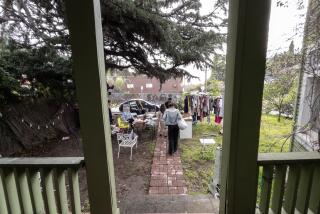A ‘Paradise’ Lost to Progress
- Share via
Abigail Stark’s father was white and her mother was a former slave.
To most of their contemporaries, their principal legacy to their daughter was societal disapproval. But Abigail, who lived most of her life in poverty’s shadow, believed her parents had bequeathed her a little “paradise” on Los Angeles’ South Flower Street. And, for 70 years, a woman known for her goodness and strength of character defended it against all comers, defying the prevailing civic ethic that the land’s only value is its price per square foot.
Stark’s father, a carpenter, purchased the parcel between Figueroa and Flower streets and 7th and 8th streets in 1870 for $450. By 1930, the small, faded green house he built at 723 S. Flower St. was worth $8,000 per front foot. It was known as “the highest-priced piece of real estate in L.A. devoted to single-family residence purpose” and sat in the middle of what was by then downtown’s premier shopping district.
Abigail Stark’s family saga began with an adulterous love affair in the decade before the Civil War, between Robert Edwin Stark, a Kentucky plantation owner, and Catherine, then one of his young slaves and, later, the common-law wife who bore his daughter.
*
After Stark’s wife, Virginia, died and the Civil War grew nearer, Stark, along with Catherine and the children of his first wife, escaped the South for a new life in the Wild West.
Their long journey in a covered wagon ended on a cattle ranch in Newhall, where their daughter, Abigail, was born in 1859.
Disenchanted with the hard ranching life and barren land, and after a series of range fires in 1870, the family abandoned the range and moved to the city.
Yearning for civilization’s comforts, but unwilling to abandon a slower, simpler life, Robert Stark purchased a country lot for $450, formerly owned by horticulturist and philanthropist Ozro Childs.
Setting out to cultivate paradise, Stark planted fruit trees and built, along with a carpenter friend, a four-room house for his family.
Just as the horizon appeared boundless, Stark died, leaving Abigail and her mother to fend for themselves. Stark’s children from his first marriage had already died or struck out on their own.
Together over the next four decades, Abigail and her mother struggled to maintain their hold on their land, which was by then coveted by politicians and developers. They plunged into their dwindling savings and purchased a Glendale house for income, leasing it to a friend.
But after her mother died in the teens, and property taxes began eating away at her budget, Abigail was forced to sell pieces of her downtown paradise. She divided her front porch into rental space for two sidewalk businesses: a locksmith and a shoeshine stand.
In the 1920s, a boom time, the downtown shopping district-- the counterpart to Manhattan’s Fifth Avenue--was bustling along 7th Street. Stark sold yet another piece of her property to Barker Brothers, while leasing the lot on the south side of her home to a parking lot.
*
Her shrewd business sense paid off, even though her heating bill rocketed and her plants began dying when the towering buildings springing up around her blocked out the sun. She still refused to sell.
In 1939, Stark, who had never married, died at age 80 and 19 people, including the descendants of her white siblings, were scrapping and suing over what seemed a fortune.
Thirteen days before her death, Stark made a will that left the bulk of her estate, $35,000, to her physician, Dr. Ronald Cummings. She bequeathed $10,000 to Daisy Carter, the nurse who cared for her in her final illness; $10,000 to A.J. Clark, manager of her bank; $10,000 to Edward Inch, an employee of a nearby store; and left the Glendale house to tenant and friend Jane Green.
The locksmith, Sam Smith, got $2,500 and the shoeshine man, Charlie Williams, got $1,000. He sued Stark’s estate unsuccessfully for an additional $4,116 for “running errands and protecting her from the eyes of the curious public.”
Over the next three years, people came out of the woodwork--even a convicted felon--claiming to be descendants of Stark or her parents. All their claims were eventually denied.
Since interracial marriages were then illegal, Judge Charles E. Haas’ decision cited a California Supreme Court ruling that “children born of white-Negro parentage were illegitimate, and that consequently there was no relationship between Stark’s white half-brothers and sisters and herself.”
A convict in Kansas, sentenced to 99 years for embezzlement with eight prior felony convictions, claimed he was Stark’s only son and heir. His claim was also denied on the grounds that “a person incarcerated for such a term is civilly deceased and has no legal right to inherit an estate.”
To Abigail Stark, it all would have seemed beside the point: Her paradise was paved over in short order.
More to Read
Inside the business of entertainment
The Wide Shot brings you news, analysis and insights on everything from streaming wars to production — and what it all means for the future.
You may occasionally receive promotional content from the Los Angeles Times.










